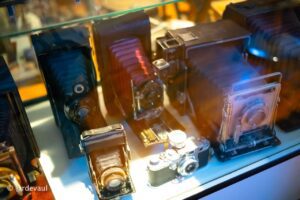If you are of a certain age, you may remember a time when part of your vacation budget included the cost of purchasing and developing film. Others of a younger generation may recall when the digital camera reigned supreme and you were no longer inhibited by the typical 24 to 36 exposures of the 35mm format (although whether you ever managed to print those photos was questionable.) Today, the opportunity to capture a moment in time and have it viewed by anybody and everybody is all the more easier thanks to the advent of smartphone camera capabilities and social media. Even if you prefer to use a digital camera over your smartphone to take photos, photographers at INF Photo share that good quality DSLRs are very affordable now.
Over the course of the twentieth century the camera industry experienced a spectacular rise, peaking in 2010 when more than 121 million new cameras were being produced, according to data released by Statista. However, just eight years later it had seen a catastrophic fall, with the number dropping by 84 percent to 19 million. Kodak was the leading film photography company for the majority of the industry’s growth but by 2012 the company had declared bankruptcy, having failed to compete in the digital photography world they helped to create.
Unlike Kodak and other camera brands that have suffered similar fates, Leica has managed to not only survive in an increasingly digital world, but thrive. Even now as practically everybody is walking around with an excellent camera in their pocket at all times and the camera industry shrinks with rapidity, Leica’s strong link between functional design and heritage have seen it weather the storm and maintain its reputation as the world’s best lensmaker, with its M series cameras have reached a status that is comparable to that of a Rolex or Rolls Royce.
Innovation professional and photography enthusiast Richard DeVaul believes that the secret behind Leica’s success lies in its design. As an owner of the Leica M10 rangefinder himself, he said of the camera:
“It’s one of the most elegant pieces of functional technology I’ve ever used. And a lot of the design’s the same as it was literally, in the 1960s. It has a modern digital sensor and some other things, but I think it’s a great example of a really mature technology.”
DeVaul’s career spans over twenty years working on innovation in companies large and small. From small teams in startups to Fortune 100 companies such as Apple and X Development (formerly Google X), DeVaul’s path has led him to garner unique insight into the importance of design within innovation, and why that can mean the difference between success and failure for the many companies like Leica who are working to compete in a world that is evolving with increasing rapidity. Below we explore with him Leica’s historical focus on design, and how good design impacts innovation as a whole.
The history of the Leica camera
 Founded in 1849 by the German optical engineer Enrst Leitz, Leica was originally a glasses and telescope manufacturer. Fifty years later in the early 1900’s, employee Oskar Barnack realized that the company’s lenses could be used to build a fast, lightweight, portable camera that could compete with the bulky and difficult to carry models that were typical of the day. An optician and photographer himself, Barnack sought to create a camera that could be used for landscape photography, particularly on mountain hikes when lugging heavy equipment around was impractical at best. Fitting the camera with a Leitz anastigmat 50mm f/3.5 lens, he built a still camera for 35mm perforated film called the Ur-Leica in 1914 and by 1925 the refined and improved version of Barnack’s camera went into serial production under the name of Leica I.
Founded in 1849 by the German optical engineer Enrst Leitz, Leica was originally a glasses and telescope manufacturer. Fifty years later in the early 1900’s, employee Oskar Barnack realized that the company’s lenses could be used to build a fast, lightweight, portable camera that could compete with the bulky and difficult to carry models that were typical of the day. An optician and photographer himself, Barnack sought to create a camera that could be used for landscape photography, particularly on mountain hikes when lugging heavy equipment around was impractical at best. Fitting the camera with a Leitz anastigmat 50mm f/3.5 lens, he built a still camera for 35mm perforated film called the Ur-Leica in 1914 and by 1925 the refined and improved version of Barnack’s camera went into serial production under the name of Leica I.
A portmanteau of “Leitz” and “camera,” the Leica I was the first commercially-available 35mm still camera, and by the time the Leica II was released with detachable and interchangeable lenses professional photographers had realized that the camera offered them the freedom to shoot dynamically in extraordinarily high quality. These attributes are said to have sparked the growth in photojournalism in the 20th century. From the U.S. Navy sailor stealing a kiss from a stranger in Times Square following the end of World War II, to Che Guevara’s iconic portrait that has been painted, printed, digitized, embroidered, tattooed, silk-screened, sculpted or sketched on nearly every surface imaginable, to Napalm Girl, the Pulitzer Prize-winning photograph that was said to have helped put an end to the Vietnam War soon afterwards. All of these images were captured through Leica’s signature lenses.
Pairing essential design with calculated innovation
Leica’s design today has remained like the Bauhaus style that was popular at the time of the original rangefinder’s launch: keeping everything essential while making sure it stands up against advancing technology and innovation. Although Barnack’s camera has been updated slowly over the decades to become Leica’s current M-range, which now includes cameras using its traditional 35mm film format and digital versions, the simple styling has meant that the cameras have never been in danger of becoming outdated. This focus on simplicity has stopped it falling prey to the call of bells and whistles that many other high-end cameras feature today: the Leica is stripped down the core elements that a photographer needs.
Leica’s devotion to producing a quality product is what has allowed them to produce cameras that other brands can’t match. The Leica M series is made up of over 1,000 individual parts, pieced together with the utmost precision by highly-trained technicians. Much of the assembly is done by hand, a feat unachievable for many others within the camera industry which must rely on mass production to generate sales. Additionally, with its roots in lens production, the Leica lens is said to have no equal. Leica’s lens glass is ground and polished to create an aspherical lens, comprising a complex shape and surface ideal for optics. It’s so sharp on its own there is little need for post-production sharpening. They are manufactured in a sterile environment free of any potential contaminants, and they undergo an ultrasonic bath to remove any debris and are closely inspected for dust and any other cosmetic issues. The sensitivity of this glass means that it can be damaged by any contact and even exposure to air, meaning it must be shipped in special soft paper.
“When I was at Apple and at X I worked on some computational photography stuff,” said DeVaul. “And it’s really amazing how much of what we think of as a great picture, is actually the result of software analysis versus lens … at least on a smartphone like the iPhone 12. My old school Leica camera is very different. It’s basically just incredibly beautiful optical engineering.”
While the focus on attention to detail during manufacturing is a feature of Leica that has withstood the test of time, this isn’t to say that they haven’t evolved with the increasingly digital world. In fact, many of the innovations within the camera industry come from Leica, not just in terms of megapixels but from stripping down the core elements that a photographer needs and producing cameras that perhaps other brands can’t because theirs are mass-manufactured. A prime example of this is the Leica M Monochrom, the world’s first digital black-and-white camera. On a regular camera, the black-and-white mode functions by applying a filter to a color photograph, but with Leica’s special-edition model it shoots exclusively in black-and-white, harking back to the heyday of film cameras but with all of the functionality expected of a 21st-century digital camera.
The relationship between design and innovation
 DeVaul says that “design is often misunderstood as making things pretty after all of the hard work is done. Nothing could be further from the truth. Design is the process by which the potential value of solving a problem is realized in practice.” According to DeVaul, the idea of innovation has been co-opted into a marketing buzzword. True innovation involves interrupting the existing order of things, destroying the status quo as Barnack did with the Ur-Leica a century ago. A great innovator harnesses the power of great design, and DeVaul says that winning in innovation usually comes down to who can iterate and learn most effectively, not who can be the most creative or produce the most radical ideas. Kodak actually invented the first self-contained digital camera in 1975, but ended up lacking the foresight to iterate on the technologies they themselves helped create. Conversely, Leica has found a way to rely on their original innovative design, iterating but never deviating from what sets them apart within the camera industry.
DeVaul says that “design is often misunderstood as making things pretty after all of the hard work is done. Nothing could be further from the truth. Design is the process by which the potential value of solving a problem is realized in practice.” According to DeVaul, the idea of innovation has been co-opted into a marketing buzzword. True innovation involves interrupting the existing order of things, destroying the status quo as Barnack did with the Ur-Leica a century ago. A great innovator harnesses the power of great design, and DeVaul says that winning in innovation usually comes down to who can iterate and learn most effectively, not who can be the most creative or produce the most radical ideas. Kodak actually invented the first self-contained digital camera in 1975, but ended up lacking the foresight to iterate on the technologies they themselves helped create. Conversely, Leica has found a way to rely on their original innovative design, iterating but never deviating from what sets them apart within the camera industry.
Designers “are the people who fundamentally really deeply understand a problem,” says DeVaul, and Leica’s designers understand that while photography is becoming an increasingly accessible art form thanks to smartphone technology, there are still those who wish to connect with the fundamentals of photography and will appreciate the brand’s commitment to unmatched quality. Leica has incredible design, and it uses technology to fulfill those design wishes, coming up with products that don’t necessarily follow the trend, but create their own paths. Perhaps fittingly, Leica itself may have put it best, saying “Classics are works that are immune to the passing whims of the present. They are never rewritten, but re-interpreted on the basis of a changed world.”




































